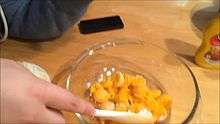Deviled egg
|
A plate of deviled eggs | |
| Alternative names | stuffed eggs, angel eggs, eggs mimosa, Russian eggs, dressed eggs, picnic eggs |
|---|---|
| Course | Hors d'oeuvre |
| Place of origin | Italy |
| Region or state | Rome |
| Serving temperature | Cold |
| Main ingredients | Eggs, mayonnaise, mustard |
| Variations | Multiple |
| 200 kcal (837 kJ) | |
|
| |
Deviled eggs (US) or devilled eggs (UK), also known as stuffed eggs, angel eggs, eggs mimosa, Russian eggs, dressed eggs, or picnic eggs are hard-boiled eggs that have been shelled, cut in half, and filled with a paste made from the egg yolks mixed with other ingredients such as mayonnaise and mustard.[1] They are generally served cold as a side dish, appetizer or a main course, often for holidays or parties.
Etymology
The term "deviled", in reference to food, was in use in the 18th century, with the first known print reference appearing in 1786.[2] In the 19th century, it came to be used most often with spicy or zesty food, including eggs prepared with mustard, pepper or other ingredients stuffed in the yolk cavity.
In parts of the Southern and Midwestern United States, the terms "stuffed eggs", "salad eggs", "dressed eggs", or "angel eggs" are also used, particularly when served in connection with church functions, avoiding the Devil's name. The term "angel eggs" has also been used in association with deviled eggs stuffed with "healthier" (less fat and cholesterol) alternatives.[3]
Preparation

Cooled hard-boiled eggs are peeled and halved lengthwise, and the yolks are removed. The yolks are then mashed and mixed with a variety of other ingredients, such as mayonnaise and mustard.[4] Tartar sauce or Worcestershire sauce are also frequently used. Other common flavorings include: diced pickle or pickle relish, salt, ground black pepper, powdered cayenne pepper or chipotle chillies, turmeric, vinegar, ketchup, green olives, pimentos, poppyseed, thyme, cilantro, minced onion, pickle brine, caviar, cream, capers, and sour cream.
The yolk mixture is then scooped into each egg "cup" made from the firm egg whites. Old Bay, paprika, curry powder, cayenne, chives, or dill may be sprinkled on top as a garnish. The finished eggs may be further decorated with caviar, anchovy, bacon, shrimp or herring.
Flavorings
Contemporary versions of deviled eggs tend to include a wider range of seasonings and added foods, such as garlic, horseradish, wasabi, sliced jalapeños, cheese, chutney, capers, salsa, hot sauce, ham, mushrooms, spinach, sour cream, caviar, shrimp, smoked salmon or other seafood, and sardines.
In different countries
The deviled egg can be seen in recipes as far back as ancient Rome, where they were traditionally served as a first course.[5][6] The dish is still popular across the continent of Europe and in North America.
In France, it is called œuf mimosa; in Hungary, töltött tojás ("stuffed egg") or kaszinótojás ("casino egg"); in Romania, ouă umplute ("stuffed eggs"); in the Netherlands gevuld ei ("stuffed egg"); in Sweden fyllda ägg ("stuffed eggs"); on the island of Malta it is called bajd mimli ("stuffed eggs").
In many European countries, especially Belgium, France, the Netherlands and Germany, a variation is served known as "Russian eggs". This consists of eggs cut in half, served with vegetable macédoine and garnished with mayonnaise, parsley and tomato.[7] Contrary to what the name might suggest, the dish does not originate in Russia; its name derives from the fact that the eggs are served on a bed of macédoine, which is sometimes called "Russian salad". In the Black Forest region of Germany, Russian eggs may be garnished with caviar.[8]
In Sweden, the deviled egg is a traditional dish for the Easter Smörgåsbord, where the yolk is mixed with caviar, cream or sour cream, optionally chopped red onion, and decorated with chopped chives or dill, perhaps with a piece of anchovy or pickled herring. In French cuisine, the other ingredients are most likely to be pepper and parsley. In Hungarian cuisine, the yolks are mashed and mixed with white bread soaked in milk, mustard and parsley, often served as an appetizer with mayonnaise, or as a main course baked in the oven with Hungarian sour cream topping and served with French fries. Other common flavorings of the yolks in German cuisine are anchovy, cheese and caper.
Deviled eggs are a common dish in the United States. In the Midwestern and Southern U.S., they are commonly served as hors d'oeuvres before a full meal is served, often during the Christmas season. Deviled eggs are so popular in the United States that special trays are sold specifically for serving them. Prepared and packaged deviled eggs are now available in some U.S. supermarkets.
In parts of South America, they are called huevos a la peruana.[9]
See also
References
- ↑ Robert A. Palmatier, "Food: a dictionary of literal & nonliteral terms" Westport: Greenwood Press, 2000. p. 96
- ↑ The Straight Dope: What's up with "deviled" eggs, ham, etc.? October 12, 2004.
- ↑ Collins, Richard, MD, FACC (2013-03-29). "Angel Eggs Not Deviled Eggs". The Cooking Cardiologist. Archived from the original on 2014-07-26. Retrieved 2014-07-19.
- ↑ The Art of Making Devilled Eggs (2008-08-08)
- ↑ Rebecca Katz (26 February 2013). The Longevity Kitchen: Satisfying, Big-Flavor Recipes Featuring the Top 16 Age-Busting Power Foods. Random House Digital, Inc. pp. 173–. ISBN 978-1-60774-294-4. Retrieved 18 March 2013.
- ↑ http://www.history.com/news/hungry-history/the-ancient-history-of-deviled-eggs
- ↑ "Oeufs à la russe – Les recettes de François". France 3 (in French). Retrieved 11 July 2012.
- ↑ Russian Eggs, Black Forest Cuisine, Walter Staib, accessed July 10, 2012
- ↑ http://www.nova.cl/cocina-y-recetas/huevos-a-la-peruana-con-ensalada-de-tomates/
| Wikimedia Commons has media related to Deviled eggs. |
